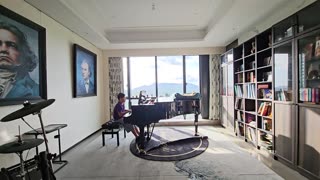Premium Only Content

Pop Song 145 'Running to Stand Still' U2 1987
Pop Song 145 'Running to Stand Still' U2 1987
A slow ballad based on piano and guitar, it describes a heroin-addicted couple living in Dublin's Ballymun flats; the towers have since become associated with the song. Though a lot of time was dedicated to the lyrics, the music was improvised with co-producer Daniel Lanois during a recording session for the album.
The group explored American music for The Joshua Tree, and as such, "Running to Stand Still" demonstrates folk rock and acoustic blues influences. The song was praised by critics, many of them calling it one of the record's best tracks
"Running to Stand Still" was written by U2 in the context of the heroin addiction epidemic in Dublin of the 1980s, much like "Bad" (and to some extent "Wire") had been from their 1984 album The Unforgettable Fire. Bassist Adam Clayton has referred to the song as "Bad Part II". Thin Lizzy frontman Phil Lynott's decline and death from addiction also resonated with Clayton at the time.
Until their 2014 album Songs of Innocence, U2 had written relatively few songs directly related to their growing up in Dublin, often giving higher priority to works about The Troubles in Northern Ireland or to international concerns. When they have written about Dublin, allusions to it have often been disguised. But "Running to Stand Still" was one of those with specific Dublin connections
I see seven towers
But I only see one way out
This lyric was a reference to the Ballymun flats, a group of seven local authority, high-rise residential tower blocks built in the Ballymun neighborhood of Dublin during the 1960s. Paul Hewson (later known as U2's lead vocalist Bono) had grown up on Cedarwood Road in the adjacent Glasnevin neighborhood, in a house across fields behind the towers, near his friends and future artists Fionán Hanvey (later known as Gavin Friday) and Derek Rowan (later known as Guggi). Bono had played in the towers' foundations as they were being built, then traveled in their elevators for the novel experience. Over time, poor maintenance, lack of facilities for children, transient tenancies, and other factors caused social conditions and communal ties to break down in the flats. The place began to stink of urine and vomit, and glue sniffers and used needles were common sights, as were appearances of the Garda Síochána. Guggi later lived in the towers during years that he was struggling personally with drugs. It was through his exposure to people without hope in the flats that Bono began to develop his social consciousness.
Bono may have used Ballymun as the inspiration (without any explicit lyrical references to it) for the 1980 U2 song "Shadows and Tall Trees", and later likened living in the area to some of the scenes portrayed in the 1992 Mike Newell film Into the West. Driving by there in 1987, Bono said, "See the seven tall buildings there? They're 'the seven towers.' They have the highest suicide rate in Ireland. After they discovered everywhere else in the world that you don't put people living on top of each other, we built them here.
The song's title phrase originated from Bono asking his brother how his struggling business was going, and the brother responding, "It's like running to stand still." Bono had not heard the phrase before, and he thought it expressed what heroin addiction and the effects of the drug on the body were like; a writer later described the title as a "perfect distillation of the dynamic of feeding on addiction." Bono had heard a real story about a pair of heroin addicts, a man and a woman, who lived in the Ballymun towers. Out of money and unable to pay the rent due to their habit, the man became a heroin smuggler, operating between Dublin and Amsterdam and taking enormous risks for a big payday. Bono felt the man was decent at heart but was constrained by his squalid living conditions, as well as poor choices, and Bono wanted to illustrate how these poor conditions affected their lives. The resulting lyric does not describe any of this explicitly, but instead limns the emotional atmosphere that the couple live in. In doing so, the song is not judgmental and shows sympathy for the woman. A character monologue from Wim Wenders' 1984 film Paris, Texas, was also a significant influence on Bono's writing of the song
-
 1:40
1:40
Cyrus Saladin Ming
2 hours agoPop Song 642 of 1000 'Ain't Going Down/'Til the Sun Comes Up' Garth Brooks 1993
4 -
 4:20
4:20
Cyrus Saladin Ming
3 years agoPop Song 122 'Running on Empty' Jackson Browne 1977
48 -
 0:39
0:39
Barousseworks
3 years agoPlant stand
241 -
 2:04:40
2:04:40
I_Came_With_Fire_Podcast
14 hours agoCartels vs The United States, Fentanyls 2 Front WAR, and FTOs
31.2K -
 4:54
4:54
CryptoWrld
15 hours ago $1.94 earnedCrypto Startup Launches Tokenized US Treasury Bonds
31.1K4 -
 2:29:15
2:29:15
We Like Shooting
21 hours ago $1.25 earnedWe Like Shooting 596 (Gun Podcast)
22.5K -
 54:43
54:43
Kimberly Guilfoyle
14 hours agoThe Trump Effect: Mexico Folds, Live with Dinesh D’Souza & Chuck DeVore | Ep.193
106K34 -
 1:20:47
1:20:47
Redacted News
13 hours agoMexico CAVES to Trump over tariffs, USAID Shutdown, & Zelensky loses $200 billion | Redacted Live
188K467 -
 1:02:29
1:02:29
The StoneZONE with Roger Stone
9 hours agoIs GOP Sen. Bill Cassidy Playing Politics with RFK Jr. Vote as U.S. Faces Public Health Crisis?
37.5K5 -
 1:10:30
1:10:30
BIG NEM
12 hours ago📢 THE JOLLOF-OFF: The Battle for West African Cuisine! 🇳🇬🔥🇬🇭
31.2K4